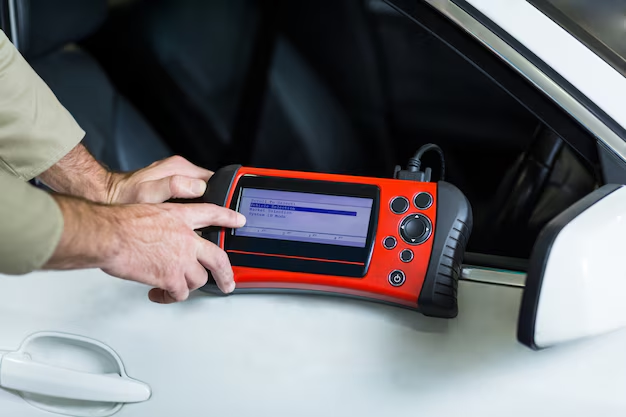So, feeling like your car’s got more to give?
Maybe it’s just not as responsive as you’d like, or you suspect there’s hidden potential lurking under the hood. Performance chip and ECU tuning are often mentioned as ways to unlock that extra oomph in modern engines. But the key question is: what exactly sets them apart, and which path is right for you?
Let’s simplify things and look at this from a practical perspective, ensuring you make the best decision for your ride.
ECU Tuning: Rewriting the Rules
ECU tuning, or remapping as it’s sometimes called, essentially involves tweaking the software that governs your car’s engine.
Think of the ECU—Engine Control Unit—as the car’s central nervous system. It’s responsible for a host of functions, from fuel injection to ignition timing, turbo boost control, and countless other factors that dictate engine performance.
Here’s a typical ECU tuning scenario:
- A tuner links up to your car’s OBD2 port (that same connector your mechanic uses for diagnostics).
- They then download the existing ECU software, known as a “map.”
- Using specialized software, they fine-tune crucial parameters such as ignition timing, turbo boost, and the air-fuel mixture.
- The revised map is uploaded back into the ECU, the car is tested, and the settings are further adjusted as needed.
The payoff? A more responsive car, with snappier acceleration, improved throttle response, and often, surprisingly, better fuel economy under normal driving conditions. In my experience, this is where a skilled tuner really shines.
Tuning Chips: The Plug-and-Play Approach
A tuning chip – also called a plug-and-play performance module – is an external gadget that hooks up to your car, typically via the OBD2 port or engine sensors. It tweaks engine settings without making permanent changes to the ECU software.
Envision it as a helpful assistant that gives the ECU real-time instructions to modify its behavior.
Many drivers find tuning chips appealing for these reasons:
- No permanent alterations: The original ECU map remains untouched.
- Easy installation: Just plug it in, select a mode, and you’re ready to go.
- Reversible: You can remove it whenever you like, returning the car to its factory settings.
- Safe enhancements: Operates within safe limits to boost power and efficiency.
For those seeking noticeable gains without the risks or complexities of flashing the ECU, tuning chips are a solid option.
ECU Tuning vs. Tuning Chip: A Head-to-Head
Both methods aim to improve performance, but their approaches differ considerably. Here’s a quick breakdown:
| Feature | ECU Tuning | Tuning Chip |
| Method | Direct ECU software modification | Real-time signal adjustments |
| Installation | Requires a qualified professional | DIY-friendly (plug-and-play) |
| Reversibility | Permanent (unless reflashed to stock) | Fully reversible |
| Customization | Highly tailored to the specific car | Adjustable modes (Eco, Sport, Race) |
| Safety | Safe, when performed by experts | Generally safer for average drivers |
| Warranty | Could potentially void the factory warranty | Usually doesn’t impact warranty |
| Cost | Typically more expensive | More budget-friendly |
If you’re striving for peak performance and want to extract every last bit of safe horsepower from your engine, ECU tuning is the clear choice. I’ve seen incredible results when done right.
However, for flexibility, ease of use, and peace of mind, a tuning chip offers a smarter, less risky alternative.
Power Expectations: What Can You Realistically Gain?
Now, let’s talk numbers – the fun part.
The extent of the gains depends on the engine type:
- Turbocharged engines: Power increases of +15–30% (and sometimes even more)
- Naturally aspirated engines: Power gains of +5–10%
- Diesel engines: Significant torque increases and improved fuel efficiency
But remember, a great tune or chip doesn’t just deliver more horsepower. It transforms the driving experience. Acceleration becomes smoother, throttle lag vanishes, and mid-range torque sees a marked improvement.
Beyond Horsepower: Unexpected Perks
While many seek tuning for sheer power, the advantages extend beyond just speed.
1. Fuel Efficiency
When everything is optimized for timing and mixture, fuel consumption can actually decrease.
Many users report improvements of up to 10–15% in fuel economy during moderate driving. This, of course, depends on driving habits.
2. Throttle Response
A well-executed tune, generally speaking, tends to perk up the throttle response, which can be a real game-changer, especially in automatic transmissions that often feel a bit sluggish from the factory.
Drivability improvements? Definitely. You’ll likely find the car feels more sorted overall. Gear changes, in most cases, become smoother, and that annoying turbo lag can diminish. Engine noise, believe it or not, can even sound better.
Personalization is another perk. A tuner or performance chip – a decent one, anyway – can tailor your car’s performance to how you actually drive. City slicking? Long hauls? Towing the boat? Or maybe you’re a track day enthusiast? A good tune can adjust accordingly.
Risks and Considerations
Now, risks. Both tuning approaches, when done properly, are reasonably safe, but you’ve got to be aware.
- Dodgy tunes: A poorly written ECU map can, in some cases, cause engine knock, overheating, or emissions issues.
- Cheap chips: Those bargain-bin “eBay special” chips? They often just trick the ECU with fake data. They don’t really optimize anything. Buyer beware!
- Warranty impact: Tinkering directly with the ECU can void your warranty on a new car. So proceed with caution.
That’s why sticking with reputable brands and proven products is crucial. You want something designed specifically for your engine.
Monte Tuning: Safe Power, Simplified
Monte Tuning aims to simplify power gains. They offer two plug-and-play solutions: the Monte GT and Monte GTR. People seem to like them, and here’s why:
- Easy peasy installation — plugs right into your OBD2 port, no tools needed.
- No ECU risk — your factory map stays untouched.
- Multiple modes — choose from Eco, Sport, and Race.
- Real-time optimization — the tuner continuously monitors engine data and tweaks parameters for max efficiency and power.
- Reversible anytime — simply unplug it, and your car reverts to its original factory condition.
- Global compatibility — works with both gasoline and diesel engines.
The Monte GTR even packs an onboard screen showing virtual dyno readings, acceleration tests, and diagnostics. Cool for data junkies.
Both models come with a warranty and satisfaction guarantee, which shows Monte Tuning stands behind their products.
Which Option Fits You Best?
If you enjoy tinkering and want full control, a professional ECU tune at a dyno shop could be your thing.
But if you value flexibility and easy gains, a tuning chip might be the more straightforward solution.
In many instances, plug-and-play modules can deliver maybe 80–90% of a full remap’s gains — without the potential headaches.
Final Thoughts
Whether you choose a chip or a full ECU tune, you may never view your car the same way again. The right tune unlocks that untapped potential lurking within.
Modern cars have factory limits for safety and emissions, but that means there’s performance on reserve. Modern tech helps to access that power – and enjoy every drive a little more.
If you’re keen to feel the difference, explore tuning options.
And for a safe, simple plug-and-play solution, consider Monte Tuning’s Monte GT and GTR — trusted worldwide for turning everyday cars into something special.



